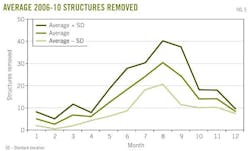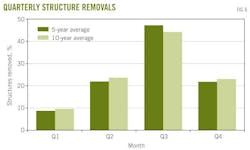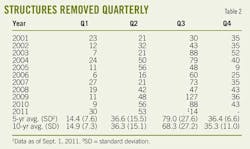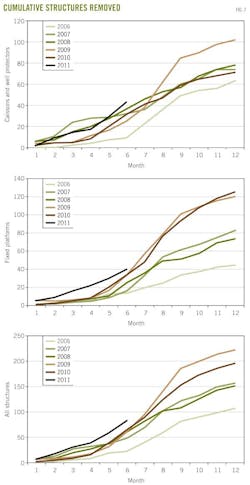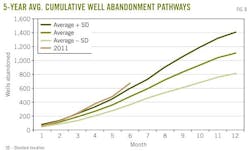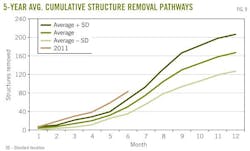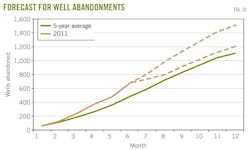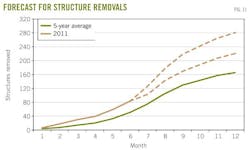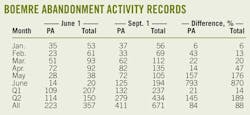P. 3 ~ Continued - Decommissioning activity forecast high for Gulf of Mexico
View Article as Single page
Structure removals
Structures are removed during decommissioning and when destroyed by hurricanes. Before structure removal, all wells must be abandoned permanently and pipelines detached and decommissioned in accord with regulatory guidelines. TA wells must be brought into PA status or provided an exemption.
Removal activity exhibits a strong seasonal component. Most work is done during the summer when favorable operating conditions prevail and service contractors can schedule activity between installation and related work (Fig. 5).
The number of structures removed during the past 5 years has ranged from 107 to 222. In 2009 and 2010, 222 and 196 structures were removed, the highest numbers ever recorded. In the first 6 months of 2011, 83 structures were decommissioned.
Activity levels generally are lowest from January through March, pick up in the second quarter, and reach peak levels during the summer before the winter season approaches (Fig. 6). Third-quarter activity is responsible for almost half the work performed during the year and is more than twice spring and fall activity combined. If a major disruption occurs during summer, service companies have a difficult time to recover.
During the last 5 years, the third quarter averaged 79 structure removals compared with 36 removals each during the second and fourth quarters and 14 removals in the first quarter (Table 2).
Fig. 7 illustrates the structure removal trends for caissons and fixed platforms. Compared with the straight lines observed for well abandonments, S-shaped curves are common, reflecting the large midseason increase in activity between July and September.
2011 activity forecast
Figs 8 and 9 show the cumulative well abandonment and structure removal trends in 2011 relative to the 5-year average and standard deviation interval.
The interval range is calculated in terms of the cumulative activity and increases along the curve.
Well abandonments during the first 6 months of 2011 exceeded the 5-year average trend line and currently are in the upper interval of historic levels. If the current trend persists, we would expect the abandonment of more than 1,200-1,500 wells by yearend (Fig. 10).
Structure removals are outpacing the 5-year average and if current trends persist, we would expect the removal of 220-280 structures in 2011 (Fig. 11).
A more formal approach for estimating yearend activity is to prorate quarterly data.
Historic trends indicate 43% of well abandonments and 31% of removal activity is performed in the first two quarters of the year, so that we would expect 671/0.43 = 1,560 well abandonments and 83/0.31 = 268 structure removals in 2011.
We can account for underreporting (see box on time lag) through an adjustment factor. The level of underreporting at any point in time is unknown. However, the closer the period between the time of evaluation and the time of the assessment, the more uncertain are the reported data.
Time lag
Decommissioning statistics frequently exhibit wide variation when reported in the trade press and in industry presentations. The lack of well-defined categories and the experience of the analyst are the primary reasons for most discrepancies, but another culprit not often mentioned is the time during the year when the analysis is performed. A time lag always exists between the operation and the recording of the final data and its availability to the public. This time lag can lead to significant differences in the numbers prepared.
Companies submit paperwork to BOEMRE within 1 month after completing the decommissioning operations, and several additional weeks will pass before BOEMRE processes and electronically records the reports.
If companies submit incomplete or inconsistent entries, the reports may be sent back for revision and resubmission that will further delay data recording.
BOEMRE updates the decommissioning databases continually but does not archive them. It does not flag entries as to whether a data element was changed or provide the date when the entry was recorded, so that time passes before the elements stabilize.
The completeness of the public records depends on the length of time from the period of interest. The shorter the time, the more uncertain is the data. Likewise, longer times provide more certain data.
For example, on Sept. 15, 2011, data compiled for third-quarter well abandonments will be incomplete, second-quarter data will be underreported, and first-quarter data should be reasonably complete and stable.
The table above shows the effect of time lag using well abandonment data compiled on July 1 and Sept. 1, 2011. On July 1, reported January well abandonments were 53, while on Sept. 1, they were 56, a 6% difference. Reported April well abandonments were 92 on July 15 and 135 on Sept. 1, a 47% difference.
We expect that differences across time will diminish the further away from the time of interest. The closer to the time of evaluation, the more incomplete and uncertain is the data.
Displaying 3/4
View Article as Single page
